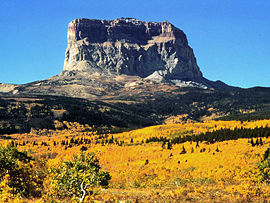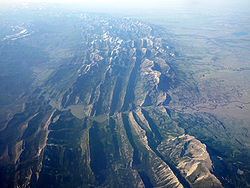
Rocky Mountain Front
Encyclopedia


U.S. state
A U.S. state is any one of the 50 federated states of the United States of America that share sovereignty with the federal government. Because of this shared sovereignty, an American is a citizen both of the federal entity and of his or her state of domicile. Four states use the official title of...
of Montana
Montana
Montana is a state in the Western United States. The western third of Montana contains numerous mountain ranges. Smaller, "island ranges" are found in the central third of the state, for a total of 77 named ranges of the Rocky Mountains. This geographical fact is reflected in the state's name,...
to southern Alberta
Alberta
Alberta is a province of Canada. It had an estimated population of 3.7 million in 2010 making it the most populous of Canada's three prairie provinces...
, Canada
Canada
Canada is a North American country consisting of ten provinces and three territories. Located in the northern part of the continent, it extends from the Atlantic Ocean in the east to the Pacific Ocean in the west, and northward into the Arctic Ocean...
. Here, the Rocky Mountains
Rocky Mountains
The Rocky Mountains are a major mountain range in western North America. The Rocky Mountains stretch more than from the northernmost part of British Columbia, in western Canada, to New Mexico, in the southwestern United States...
meet the Great Plains
Great Plains
The Great Plains are a broad expanse of flat land, much of it covered in prairie, steppe and grassland, which lies west of the Mississippi River and east of the Rocky Mountains in the United States and Canada. This area covers parts of the U.S...
and Canadian Prairie in an abrupt elevation rise of between 4,000 to 5,000 feet (1,219–1,524 m). The Lewis Overthrust
Lewis Overthrust
The Lewis Overthrust is a geologic fault structure of the Rocky Mountains within Glacier National Park in Montana, USA and Waterton Lakes National Park in Alberta, Canada, as well as into Lewis and Clark National Forest. It provides scientific insight into geologic processes happening in other...
pushed eastward and over younger aged rocks, creating the Lewis Range
Lewis Range
The Lewis Range is a mountain range located in the Rocky Mountains of northern Montana, U.S. and extreme southern Alberta, Canada. Formed by the Lewis Overthrust beginning 170 million years ago, an enormous slab of Precambrian rocks 3 miles thick, wide and long faulted and slid over newer...
.
The majority of the Rocky Mountain Front lies in Waterton Lakes National Park
Waterton Lakes National Park
Waterton Lakes National Park is a national park located in the southwest corner of Alberta, Canada, and borders Glacier National Park in Montana, USA. Waterton was Canada's fourth national park, formed in 1895 and named after Waterton Lake, in turn after the Victorian naturalist and conservationist...
in Alberta, and Glacier National Park, Lewis and Clark National Forest
Lewis and Clark National Forest
Lewis and Clark National Forest is located in west central Montana, United States. Spanning , the forest is managed as two separate zones. The eastern sections, under the Jefferson Division, is a mixture of grass and shrublands dotted with "island" pockets of forested areas. Here, cattle leases to...
as well as on private lands and the Blackfeet Indian Reservation
Blackfeet Indian Reservation
The Blackfeet Indian Reservation or Blackfeet Nation is an Indian reservation of the Blackfeet tribe in Montana in the United States. It is located east of Glacier National Park and borders Canada to the north. Cut Bank Creek and Birch Creek make up part of its eastern and southern borders...
, all of which are in Montana. The U.S. Bureau of Land Management also manages portions of the region.
Description
Also referred to as the "Crown of the Continent", the region is characterized by an uncommon ecosystem in which prairiePrairie
Prairies are considered part of the temperate grasslands, savannas, and shrublands biome by ecologists, based on similar temperate climates, moderate rainfall, and grasses, herbs, and shrubs, rather than trees, as the dominant vegetation type...
and Northern Rockies flora and fauna overlap. All of the original animal species encountered when the Lewis and Clark Expedition
Lewis and Clark Expedition
The Lewis and Clark Expedition, or ″Corps of Discovery Expedition" was the first transcontinental expedition to the Pacific Coast by the United States. Commissioned by President Thomas Jefferson and led by two Virginia-born veterans of Indian wars in the Ohio Valley, Meriwether Lewis and William...
passed through the region still exist in their wild state, with the exception of the bison
Bison
Members of the genus Bison are large, even-toed ungulates within the subfamily Bovinae. Two extant and four extinct species are recognized...
, which lives in the wild south and west of the front, but in the area itself is represented by domesticated herds. This is one of the few places in the lower 48 states in which the grizzly bear
Grizzly Bear
The grizzly bear , also known as the silvertip bear, the grizzly, or the North American brown bear, is a subspecies of brown bear that generally lives in the uplands of western North America...
still ventures onto the Great Plains. Conservationists have been actively working to protect the region from oil and gas exploration interests.

